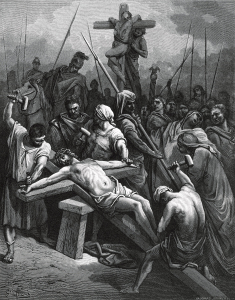Do we see the cross?
Whether we are looking at a representation of the crucifixion or of the cross alone, do we see what it actually is?
The cross, like a flag, is something that our eyes look at so often and that our minds register so symbolically that we don’t see what it truly is.
What do we see if we really look?
We see an object made of wood.
We see parts of what used to be a tree.
We see the remnant of a tree that was cut down by men with the express purpose of torturing an innocent man to death.
We see the perversion of humanity and Creation.
Humanity’s purpose is to love God, love each other, and care for Creation in the way a good shepherd cares for his sheep. Instead, in the image of Jesus on the cross we see humanity rejecting God, using its creative capacities in dark and awful ways against a neighbor, and ending the life of one of the living things of God’s earth for that dark and awful purpose.
It is easy to forget all of the brutal history that comes with the cross. It is easy to forget what an odd symbol it is for a faith.

Crucifixion of Jesus. Wood engraving drawn by Gustave Doré, engraved by J. Gauchard Brunier. From Sainte Bible (1866)
The Roman Empire used the cruelty of the cross to display its power relentlessly and with maximum psychological impact.
When Spartacus led his rebellion that ultimately failed, 6,000 of the rebels were crucified on crosses that stretched from Capua to Rome in 71 B.C. Imagine that. Picture it in your mind. Crosses with dead and dying and screaming and moaning men stretching for over 100 miles. One hundred miles.
Think, too, of the systematic effort it took for the Romans to cut down all of those trees, prepare them for their dark purpose, and transport them on their web of well-designed roads, the same roads that took their armies to ever-expanding frontiers.
In short, we see in the cross a potent and complete symbol of all that is wrong with this world, including the use of God’s earth for evil purposes.
I believe we also see in the cross a symbol of all that God will put right.
Just as the Creation scene in Genesis shows God, people, and God’s earth in harmony so we perceive a vision of a new heaven and a new earth in Revelation (as well as in Isaiah) with all of Creation at peace and praising God in love and communion.
And in the cross we see all that is at stake in whether we accept this message of a loving God willing to die for us at our hands and whether we live the lives we are meant to live by following God with the help of the Spirit.
What is at stake is our relationship with God, with people, and with Creation.
If we seek Jesus out and accept God’s transforming grace and commit to ever deepening our reliance on God, our relationship with God will become close and intimate forever. If we seek Jesus out and truly accept God’s transforming grace, God’s Spirit will cause us over time to love our neighbors in thought and deed, even if they are different from us in their culture or their beliefs.
And I believe that if we seek Jesus out and fully accept God’s transforming grace, the transformation of our hearts and minds will cause us to live out a new relationship with God’s earth. This relationship will be built on our abiding concern for the earth’s life and vitality. We will strive to use God’s earth in ways that honor God, benefit all people (especially the poor and marginalized), and enable the many amazing forms of life on this planet to flourish.
And what’s the very best news of this good news is that the whole life God offers through a whole faith is the very best life we could ever live.
A life interwoven with an awareness of the patterns and life of this world is a more complete one. A life that treats the world with love, patience, kindness, and self-control is a rich and beautiful one.
It is entirely fitting then that the actual, physical cross – that mutilated tree used to harm its very Creator – be part of our symbol of our faith and what that faith means and what that faith promises.
The cross was indeed a tree.




